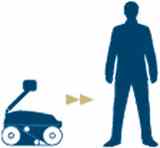| Designation: | ASENDRO |
 |
|---|---|---|
| Manufacturer: | Robowatch Technologies GmbH | |
| Product type: | Auxiliary Vehicles | |
| Name: | Robot, Unmanned Vehicle |
Conjointly with Diehl BGT Defence, a leading company on the internal and external security market, Robowatch developed the modular reconnaissance and defusing robot ASENDRO.
ASENDRO does not serve the continuous protection of outdoor facilities - unlike OFRO+detect - but it supports mission forces in assessing the situation in the field in a fast and precise manner. Within fractions of a second the modular robot analyses the hazards involved. Thanks to its remote control it is also capable of gripping and defusing dangerous objects. ASENDRO provides a solution that is tailored to the needs of fire brigades, police, military and special task forces. Conventional devices are much bigger, heavier and more complex than ASENDRO. It fits into a car boot, can climb stairs, drive through nar- row passageways or rough terrain and therefore can be used imme- diately and everywhere.
ASENDRO consists of a manoeuvrable platform and two mission-specific payload modules with a reconnaissance or manipulator arm which can be exchanged without much trouble. If there is a danger, e. g. on video-monitored open spaces, a bomb threat is received in a train station or hostage-takers hide in a building, ASENDRO SCOUT comes into action. Due to its small size (40 x 60 cm) and its relatively high speed (up to 10 km/h) it is suited for missions indoors and outdoors. The reconnaissance robot explores - controlled from a safe distance - the field and makes it possible to evaluate the situation more precisely. Through the extendable reconnaissance arm and the continuously variable pan-and-tilt camera head mounted to it, the robot transmits thermal and video images as well as sounds to the mission control centre. In this fashion it receives essential information so as to be able to intervene speedily and rescue people in danger.
Moreover, means of public transport are a primary target for criminal actions: train attacks, aircraft hijacking, bomb threats, but also attacks such as the ones in Tokyo, the United States, Madrid or London have shown how vulnerable our society is. If the mission forces discover a suspicious object in a litter bin or under a vehicle seat, such as an unattended suitcase that has to be inspected more closely, the ASENDRO EOD is in great demand. The robot, which is equipped with a manipulator arm, is precisely moved by means of the control unit developed by Diehl BGT Defence. Thanks to the telepresence technique the gripper arm can be manoeuvred synchronously with the head or hand movement of the operator. At the front end of the arm two stereo cameras are mounted which transmit their data to a helmet display. This enables the operator - with the eyes of the robot - to have a three dimensional view, to estimate the distance from objects and to grip them exactly. ASENDRO EOD can examine and move objects and open doors or windows with its gripper. Furthermore, defusing tasks can be solved in complex situations or in narrow places because of its manoeuvrable platform and precise control. In this way ASENDRO EOD reaches even suspicious objects in baggage lockers of busses, trains or airplanes. It safely removes objects weighing up to five kilograms, but also very small explosive devices, such as hand grenades under a plane seat. Additional specialized tools can be fastened to the robot arm - if need arises.
By the end of this year a third payload module - the ASENDRO SCOUT+N/B/C - is planned to be available for the detection of NBC weapons. Similarly to OFRO+detect, this robot will detect life-threat- ening substances by means of various sensors. A Geiger counter will detect (A) alpha, beta and gamma radiation, a globally unique electro- chemical biosensor (B) will ensure the detection of toxins, viruses an bacteria and a multi-gas scanner (ion mobility spectrometer, briefly IMS) will detect chemical warfare agents (C), such as Sarin.
|
||||||||||
Related Articles |
|
Robotics as a Key Technology (28.03.2007) |
 |
 |
